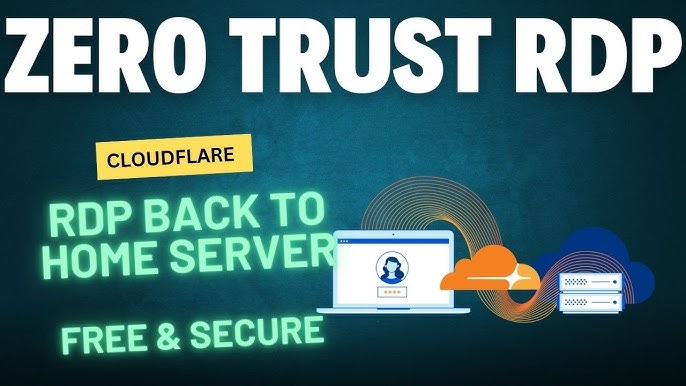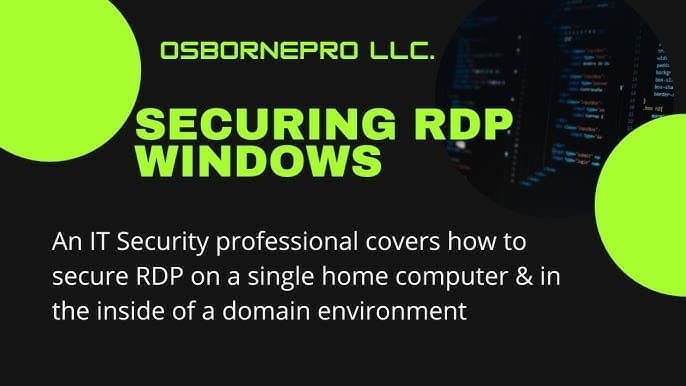Remote Desktop Protocol (RDP) lets you access your computer from afar. But security is crucial when using RDP.
Many people work from home today. They need secure connections. Cyber threats are real. Protecting your data is vital. RDP offers convenience for accessing your work computer remotely. Yet, without proper security measures, it can expose your system to risks.
Hackers target weak connections, aiming to breach your private information. This makes understanding and implementing security protocols critical. With the right approach, you can shield your home network and maintain privacy. This blog explores practical tips to secure your RDP from home. You will learn simple steps to enhance your online safety. Stay safe, and keep your data protected. Let’s dive into securing your remote desktop, ensuring peace of mind in our digital world.

Credit: www.youtube.com
Introduction To Rdp Security
Remote Desktop Protocol (RDP) is a tool for accessing computers remotely. It’s common for remote work and technical support. But, RDP connections can be targets for cyber threats. Understanding RDP security is vital for safe remote operations. It protects your data and ensures a secure connection.
Importance Of Rdp Security
RDP security is crucial for protecting sensitive data. It keeps unauthorized users from accessing your system. Without proper security, personal and business data are at risk. RDP breaches can lead to data loss or theft. Secure RDP ensures that only trusted users access your network.
Common Threats
Brute force attacks are a major threat to RDP. Hackers try multiple password combinations to gain access. Weak passwords make it easier for them. Another common threat is ransomware. Attackers encrypt files and demand payment to unlock them. Unpatched software can also be exploited by hackers. They use vulnerabilities to break into your system. Phishing scams trick users into giving away login details. These threats highlight the need for strong RDP security measures.
Setting Up Secure Rdp
Ensure a safe remote connection by setting up secure RDP from home. Use strong passwords and enable network level authentication. Regularly update software to protect against threats and maintain security.
Setting up a Secure Remote Desktop Protocol (RDP) from home is essential for protecting your personal and work data from unauthorized access. With remote work becoming more prevalent, ensuring a secure connection is no longer optional—it’s a necessity. How can you make sure your remote desktop is as secure as possible? Let’s explore some vital steps to bolster your RDP security.Choosing Strong Passwords
When setting up your RDP, the first defense line is a strong password. A good password is complex, unpredictable, and hard to guess. Avoid common words or predictable sequences like “1234” or “password.” Consider using a combination of uppercase and lowercase letters, numbers, and special characters. An example could be “P@55w0rD!2023”. This complexity makes it difficult for hackers to crack your password. Also, change your passwords regularly. It might be a hassle, but it adds an extra layer of protection. Just imagine the relief of knowing your data is secure because you took this simple step.Implementing Two-factor Authentication
Adding two-factor authentication (2FA) is like putting an extra lock on your door. Even if someone guesses your password, they can’t access your RDP without the second factor. This second factor could be a text message or an authentication app on your smartphone. It’s an additional step but an effective deterrent against unauthorized access. Think of it as a safety net. You won’t have to worry about your data’s safety every time you log in from a new location or device. Isn’t peace of mind worth a few extra seconds of your time? By choosing strong passwords and implementing two-factor authentication, you’re making a significant effort to protect your remote desktop. What other measures can you take to ensure your data remains safe? Perhaps it’s time to look into a VPN or firewall settings. Remember, securing your RDP is not just about technology; it’s about taking responsibility for your digital safety.Network Configuration
Configuring your network for secure Remote Desktop Protocol (RDP) access from home is crucial for protecting your data and privacy. You don’t want to leave any backdoors open that could compromise your sensitive information. Understanding how to set up your network effectively can make the difference between a secure connection and potential vulnerabilities.
Firewall Settings
One of the first steps in securing your RDP connection is adjusting your firewall settings. Your firewall acts as the gatekeeper, controlling what traffic can enter and exit your network. Ensure that only necessary ports are open, specifically the port used by RDP, which is usually 3389.
Consider changing the default RDP port to something less predictable. This simple tweak can significantly reduce the risk of automated attacks. Regularly audit your firewall rules to ensure they remain effective and relevant.
Vpn Utilization
Using a VPN for RDP access adds an extra layer of security by encrypting your internet traffic. This means that even if someone intercepts your data, they can’t read it. A VPN also helps mask your IP address, adding another barrier against potential intruders.
When choosing a VPN, look for one that offers strong encryption protocols and a no-logs policy. Set it up to connect automatically before establishing an RDP session. This way, you ensure that all your data is always protected, even if you forget to activate the VPN manually.
Have you ever considered how a VPN might enhance your overall online security, not just during RDP sessions? It’s a worthwhile investment in peace of mind.

Credit: forum.gl-inet.com
Regular Software Updates
Regular software updates are crucial for secure remote desktop protocol (RDP) from home. They ensure your system remains protected against vulnerabilities and cyber threats. Keeping software up-to-date can prevent unauthorized access and data breaches. It’s essential to prioritize updates to maintain a secure remote working environment.
Patch Management
Patch management is the process of identifying, acquiring, installing, and verifying patches. These patches are designed to fix security vulnerabilities. They help in maintaining the integrity and security of your RDP setup. With efficient patch management, you can ensure your system is always equipped to handle new threats. Regular patching is vital for a secure and reliable remote connection.
Automatic Updates
Automatic updates simplify the process of keeping software current. They eliminate the need for manual checks and installations. This ensures that the latest security patches are applied promptly. Automatic updates reduce the risk of missing critical updates. They provide peace of mind, knowing your system is consistently protected.
Monitoring And Auditing
Ensuring secure Remote Desktop Protocol (RDP) from home requires careful monitoring. Regular audits play a crucial role in maintaining security. These practices help identify unusual activities and potential threats. They provide insights into system usage and access patterns. By monitoring and auditing, users can prevent unauthorized access.
Log Analysis
Log analysis involves reviewing system logs to detect irregularities. It helps identify failed login attempts and unusual access times. Regularly checking logs ensures any security breaches are caught early. This process requires attention to detail and understanding of common patterns. Automated tools can assist by highlighting suspicious entries.
Real-time Alerts
Real-time alerts notify users of suspicious activities immediately. These alerts can help prevent breaches by prompting quick action. They provide instant notifications of unauthorized access attempts. Setting up alerts is essential for maintaining secure connections. They ensure users respond promptly to potential security threats.
Advanced Security Measures
Strengthen your remote work security by securing RDP from home. Implement multi-factor authentication and strong passwords to prevent unauthorized access. Regularly update your software and monitor network activity for potential threats.
Working from home has become the new normal, and with it comes the challenge of ensuring that your Remote Desktop Protocol (RDP) connections are secure. As cyber threats grow more sophisticated, protecting your remote access with advanced security measures is crucial. It’s not just about keeping hackers out; it’s about safeguarding sensitive data and maintaining your peace of mind. Let’s dive into some practical ways to bolster your RDP security.Encryption Protocols
Encryption is your first line of defense against unauthorized access. By encrypting your RDP connections, you make it significantly harder for cybercriminals to intercept and decipher your data. A practical tip is to use strong encryption protocols like TLS (Transport Layer Security) to secure your connection. Have you considered what might happen if someone could easily eavesdrop on your remote sessions? That’s where encryption comes in. It acts as a shield, ensuring that even if your data is intercepted, it remains unreadable.Intrusion Detection Systems
An Intrusion Detection System (IDS) acts like a vigilant security guard for your network. It monitors incoming traffic and alerts you to any suspicious activity. Implementing IDS can help you detect potential threats before they become full-blown security incidents. Imagine catching a burglar before they even enter your home—that’s what an IDS does for your RDP sessions. It’s an essential tool that can give you the upper hand against potential cyber attacks. Consider setting up alerts for unusual login attempts or unexpected user behavior. This proactive approach can help you respond quickly to threats, minimizing potential damage. By taking these steps, you can enjoy the flexibility of working from home without compromising on security. Are you ready to make your RDP connections as secure as possible?User Training And Awareness
Enhancing user training and awareness is crucial for secure remote desktop protocols from home. Simple steps like creating strong passwords and regularly updating software can protect sensitive data effectively. Understanding these practices empowers users to maintain security without needing advanced technical skills.
User training and awareness are key to secure remote desktop access from home. Employees often overlook security risks during daily tasks. Proper training helps them recognize threats and adopt safe practices. By understanding potential risks, they become the first line of defense. Regular sessions enhance their ability to identify and respond to security issues. Encouraging ongoing education is vital for maintaining a secure environment.Recognizing Phishing Attempts
Phishing emails trick users into giving personal information. Recognizing these attempts is crucial for security. Train users to spot unusual email addresses and links. Teach them to verify the sender’s identity before responding. Encourage them to report suspicious emails to IT immediately. Regular phishing tests can help reinforce this training.Secure Practices
Secure practices reduce the risk of unauthorized access. Encourage users to use strong, unique passwords for their accounts. Remind them to update passwords regularly and avoid using the same one across sites. Teach them the importance of logging out from RDP sessions. Advise them to avoid using public Wi-Fi for remote access. Promote the use of VPNs to encrypt their internet connection.Backup And Recovery Plans
Safeguard your remote desktop protocol (RDP) by establishing robust backup and recovery plans. Protect data from unexpected threats and ensure quick recovery. Enhance security and reliability for working from home.
Managing Secure RDP (Remote Desktop Protocol) from home is more than just setting up a connection. It’s about ensuring that your data is protected, even when things go wrong. Backup and recovery plans are essential for maintaining the integrity and availability of your information. Imagine working on a critical project when suddenly your system crashes. Without a solid backup, you risk losing all your progress. But with a recovery plan, you can quickly get back on track. Let’s dive into how you can implement effective strategies to safeguard your data.Data Backup Strategies
Creating a reliable backup strategy is crucial. Begin by identifying the data you need to protect. This might include work documents, client information, and personal files. Consider using cloud-based solutions like Google Drive or Dropbox. These services automatically save your files and allow access from anywhere. They offer an easy way to keep your data safe without needing technical expertise. You might also want to use an external hard drive. Regularly transferring important files to this device provides an additional layer of security. Remember to schedule these backups frequently. This ensures you always have the latest versions of your work.Recovery Procedures
Having a recovery plan means knowing exactly what to do when disaster strikes. Start by documenting your recovery steps. This should include how to access backups, restore files, and verify data integrity. Practice these procedures regularly. Simulate data loss scenarios to see how quickly you can restore your information. This helps you identify any weak spots in your plan and make necessary adjustments. Ask yourself: How long can you afford to be without access to your data? This will help you decide on the urgency and frequency of your recovery drills. Ensuring you’re prepared can make the difference between a minor hiccup and a major setback. By taking proactive measures, you can secure your remote work environment and continue your tasks without unnecessary interruptions.Future Of Rdp Security
As remote work becomes the norm, securing Remote Desktop Protocol (RDP) connections from home is more critical than ever. The future of RDP security is not just about tightening existing measures, but evolving with technology to ensure seamless protection. Imagine a world where your digital workspace is as secure as a physical one, where threats are anticipated and neutralized before they even appear. How can we ensure that? Let’s dive into the emerging technologies and predicted challenges shaping the future of RDP security.
Emerging Technologies
With advances in cybersecurity, new technologies are emerging to bolster RDP security. Artificial Intelligence (AI) and Machine Learning (ML) are at the forefront, offering predictive analytics to detect anomalies in real-time. These technologies learn from patterns, identifying potential threats before they become issues. You might have experienced the convenience of AI in personal gadgets, now imagine this power safeguarding your remote desktop connections.
Blockchain technology is another game-changer. It provides a decentralized security framework, ensuring data integrity and transparency. Imagine a future where your data is stored in an immutable ledger, reducing the risk of tampering or unauthorized access. These innovations are not just futuristic concepts; they are actively being integrated into security protocols today.
Biometric authentication, such as fingerprint and facial recognition, are becoming mainstream. These methods offer a layer of security that passwords alone cannot provide. Picture your home office equipped with a biometric scanner, ensuring that only you can access your work environment. Such technologies are paving the way for a secure digital workspace from home.
Predicted Challenges
Despite these advances, challenges remain. The adaptability of cybercriminals is a constant threat. As security measures evolve, so do the tactics of those looking to exploit vulnerabilities. Have you ever updated your software only to find new security alerts? This is the dynamic nature of cybersecurity.
Another challenge is user education. The most sophisticated security systems can be undermined by simple human error. Are you confident in your understanding of security protocols? Continuous education and awareness are crucial to maintaining a secure environment.
Lastly, balancing security with user convenience is a challenge. Overly complex security measures can frustrate users, leading to potential bypasses. How do you find the balance between robust security and smooth user experience? This is a question that will shape the future of RDP security.
As you navigate the world of remote work, consider these emerging technologies and challenges. How can you prepare for the future of RDP security today?

Credit: tsplus.net
Frequently Asked Questions
How Do I Make My Rdp Secure?
To secure your RDP, use strong passwords and enable Network Level Authentication. Regularly update your software and firewall. Disable unused ports and limit user access. Consider using a VPN for an additional security layer.
What Is The Most Secure Way To Rdp?
Use a VPN for secure RDP connections. Implement strong passwords and enable Network Level Authentication. Regularly update your software and use multi-factor authentication for added security. Restrict IP addresses allowed to connect and monitor sessions for suspicious activity.
Is Rdp Secure Without Vpn?
RDP without VPN can be vulnerable to cyberattacks. Use strong passwords and enable Network Level Authentication for better security. Always keep your software updated to reduce risks. Consider using VPN for an additional security layer to protect sensitive data during remote access.
Can You Encrypt Rdp?
Yes, you can encrypt Remote Desktop Protocol (RDP) connections. Use Network Level Authentication (NLA) and SSL/TLS for enhanced security. Ensure proper configuration to safeguard data against unauthorized access. Implement strong passwords and regular updates to further protect your RDP sessions.
Conclusion
Securing RDP from home is vital for your data’s safety. Use strong passwords to prevent unauthorized access. Regularly update your software to close security gaps. Enable two-factor authentication for extra protection. Monitor your connections for unusual activities. A VPN adds another layer of security.
Educate yourself about potential threats. This knowledge helps avoid risks. Always prioritize your online safety. Taking these steps ensures your remote work remains secure. Protect your data. Stay informed. Stay safe.















